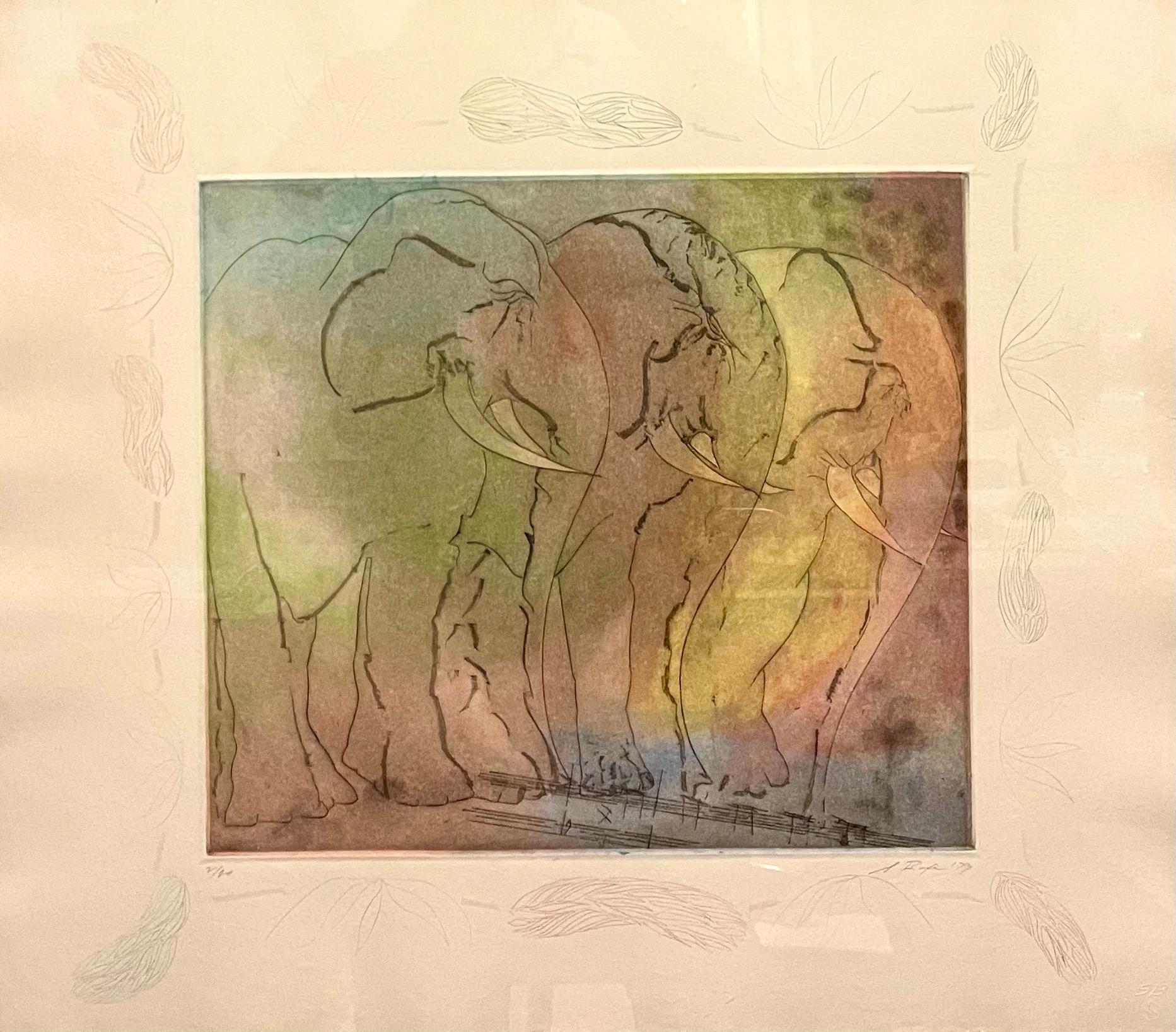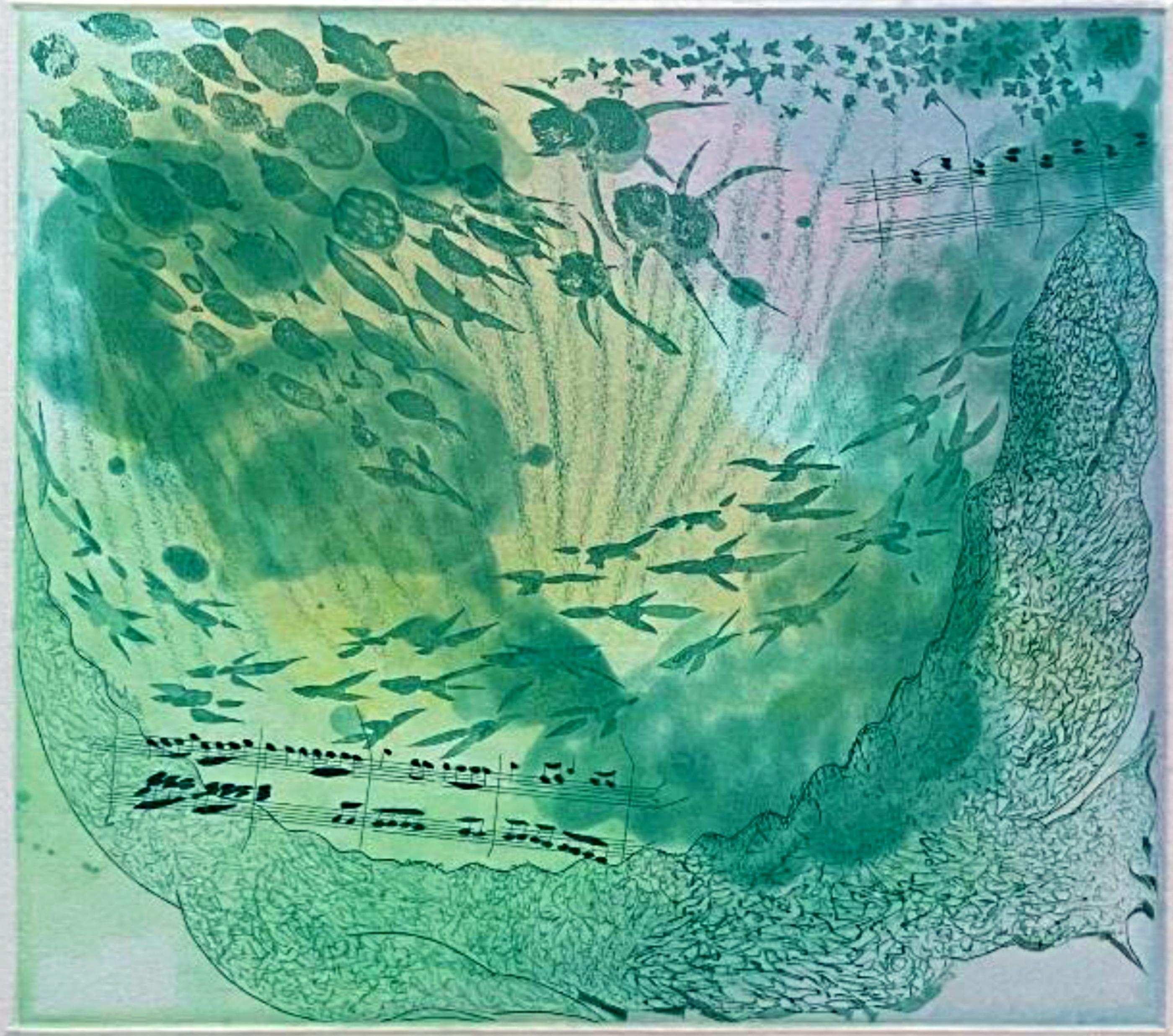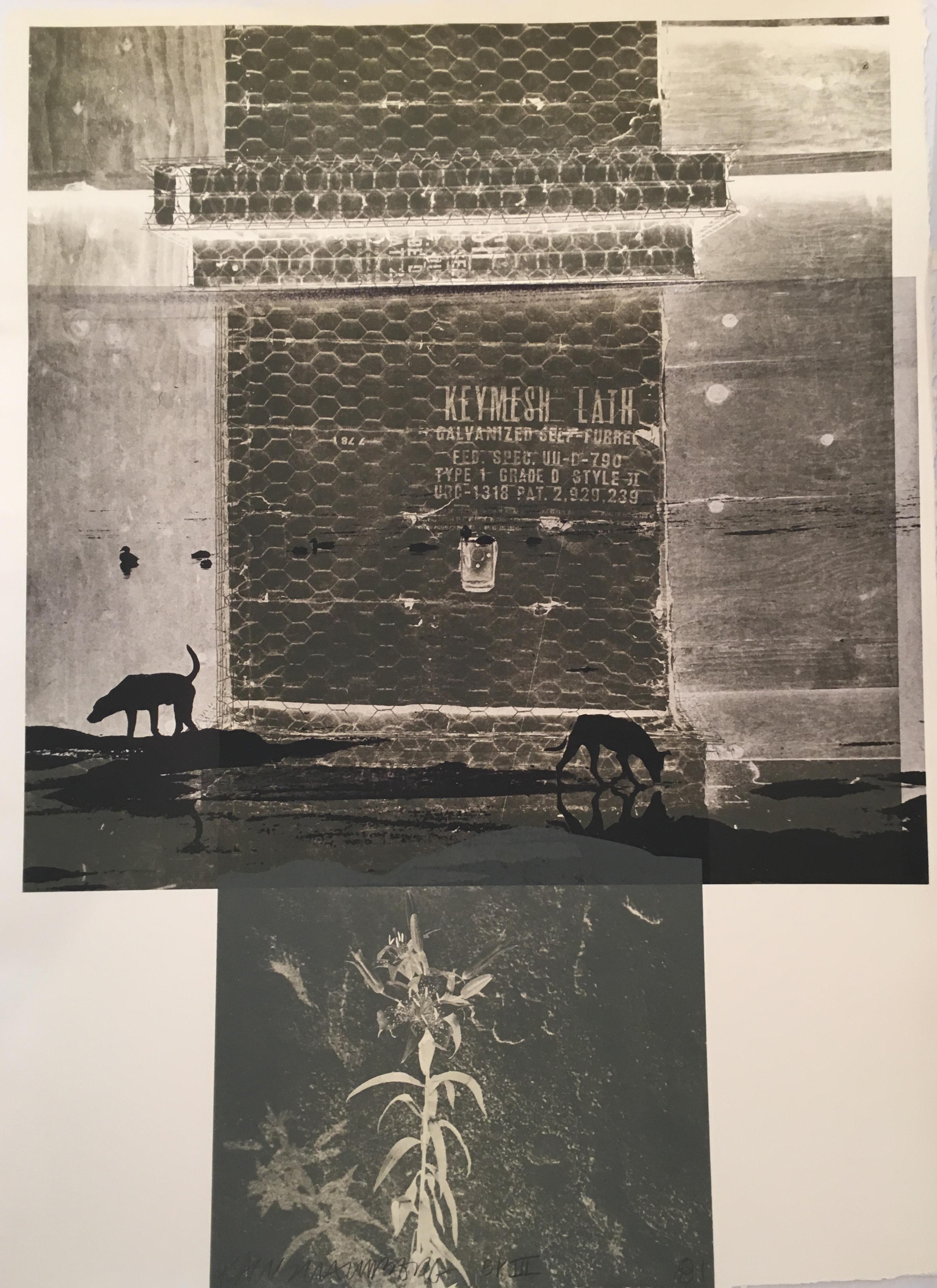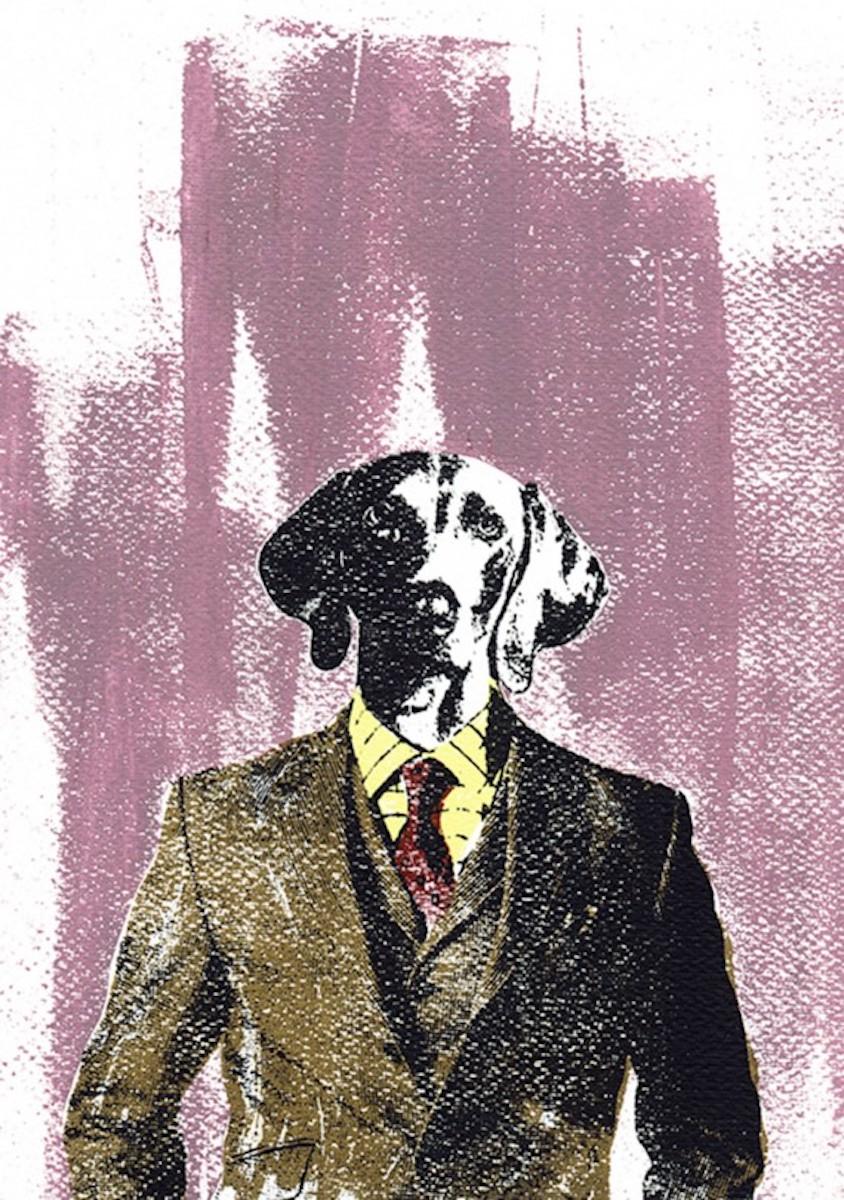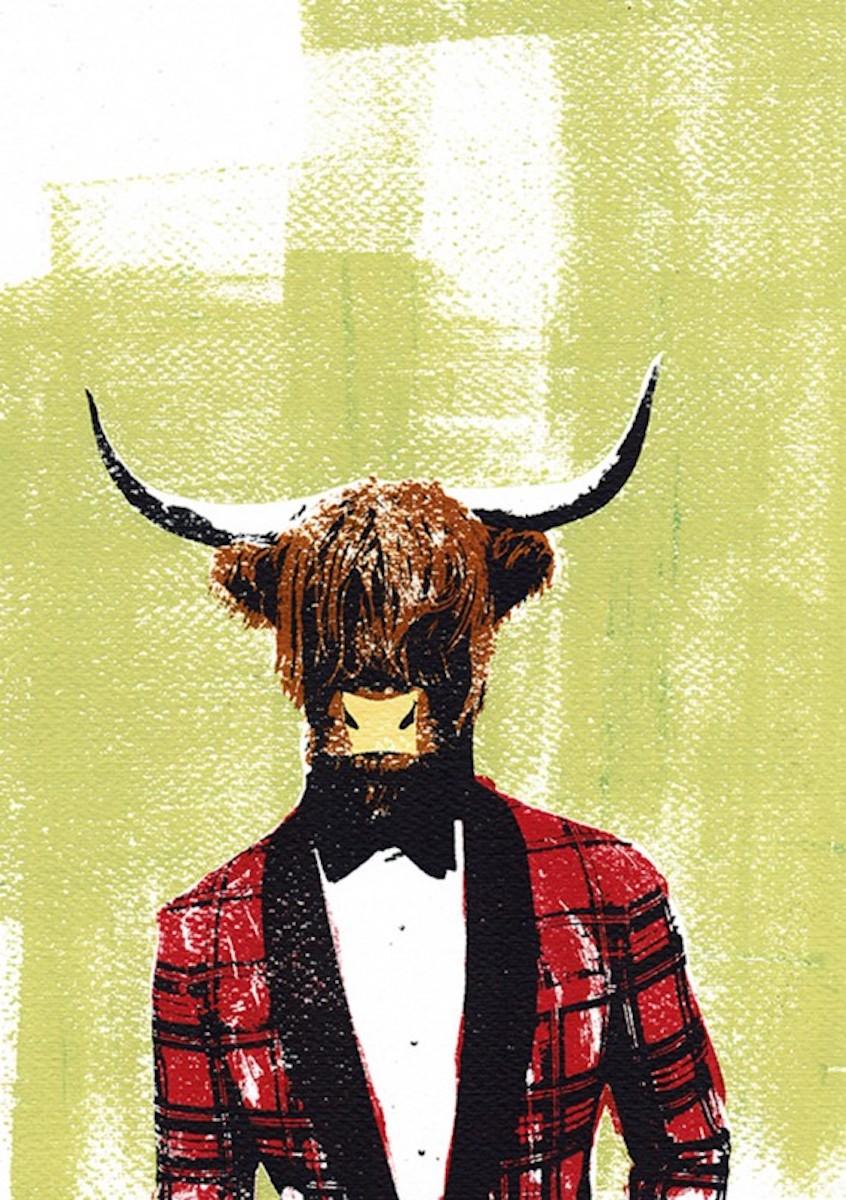Items Similar to "Palepai, " Original Woodcut Abstract Landscape Elephants signed by Carol Summers
Want more images or videos?
Request additional images or videos from the seller
1 of 9
Carol Summers"Palepai, " Original Woodcut Abstract Landscape Elephants signed by Carol Summers2008
2008
About the Item
"Palepai" is an original color woodcut by Carol Summers. The artist signed the piece in the lower right and wrote the title and the edition number lower left. Palepai are weavings from Lampurg, Sumatra, depicting a ship or ships with animals (often elephants), Gods, and people aboard. The edition number is 18/50.
12 1/2" x 17" art
19 5/8" x 24 1/4" frame
Carol Summers has worked as an artist throughout the second half of the 20th century and into the first years of the next, outliving most of his mid-century modernist peers. Initially trained as a painter, Summers was drawn to color woodcuts around 1950 and it became his specialty thereafter.
Over the years he has developed a process and style that is both innovative and readily recognizable. His art is known for it’s large scale, saturated fields of bold color, semi-abstract treatment of landscapes from around the world and a luminescent quality achieved through a printmaking process he invented.
In a career that has extended over half a century, Summers has hand-pulled approximately 245 woodcuts in editions that have typically run from 25 to 100 in number. His talent was both inherited and learned.
Born in 1925 in Kingston, a small town in upstate New York, Summers was raised in nearby Woodstock with his older sister, Mary. His parents were both artists who had met in art school in St. Louis. During the Great Depression, when Carol was growing up, his father supported the family as a medical illustrator until he could return to painting. His mother was a watercolorist and also quite knowledgeable about the different kinds of papers used for various kinds of painting. Many years later, Summers would paint or print on thinly textured paper originally collected by his mother.
From 1948 to 1951, Carol Summers trained in the classical fine and studio arts at Bard College and at the Art Students League of New York. He studied painting with Steven Hirsh and printmaking with Louis Schanker. He admired the shapes and colors favored by early modernists Paul Klee (Sw: 1879-1940) and Matt Phillips (Am: b.1927- ). After graduating, Summers quit working as a part-time carpenter and cabinetmaker (which had supported his schooling and living expenses) to focus fulltime on art. That same year, an early abstract, Bridge No. 1 was selected for a Purchase Prize in a competition sponsored by the Brooklyn Museum. In 1952, his work (Cathedral, Construction and Icarus) was shown the first time at the Museum of Modern Art in New York City in an exhibition of American woodcuts.
In 1954, Summers received a grant from the Italian government to study for a year in Italy. Woodcuts completed soon after his arrival there were almost all editions of only 8 to 25 prints, small in size, architectural in content and black and white in color. The most well-known are Siennese Landscape and Little Landscape, which depicted the area near where he resided. Summers extended this trip three more years, a decision which would have significant impact on choices of subject matter and color in the coming decade. After returning from Europe, Summers’ images continued to feature historical landmarks and events from Italy as well as from France, Spain and Greece. However, as evidenced in Aetna’s Dream, Worldwind and Arch of Triumph, a new look prevailed. These woodcuts were larger in size and in color. Some incorporated metal leaf in the creation of a collage and Summers even experimented with silkscreening. Editions were now between 20 and 50 prints in number. Most importantly, Summers employed his rubbing technique for the first time in the creation of Fantastic Garden in late 1957. Dark Vision of Xerxes, a benchmark for Summers, was the first woodcut where Summers experimented using mineral spirits as part of his printmaking process.
A Fulbright Grant as well as Fellowships from the Louis Comfort Tiffany Foundation and the Guggenheim Foundation followed soon thereafter, as did faculty positions at colleges and universities primarily in New York and Pennsylvania. During this period he married a dancer named Elaine Smithers with whom he had one son, Kyle.
Around this same time, along with fellow artist Leonard Baskin, Summers pioneered what is now referred to as the “monumental” woodcut. This term was coined in the early 1960s to denote woodcuts that were dramatically bigger than those previously created in earlier years, ones that were limited in size mostly by the size of small hand-presses. While Baskin chose figurative subject matter, serious in nature and rendered with thick, striated lines, Summers rendered much less somber images preferring to emphasize shape and color; his subject matter approached abstraction but was always firmly rooted in the landscape. In addition to working in this new, larger scale, Summers simultaneously refined a printmaking process which would eventually be called the “Carol Summers Method” or the “ Carol Summers Technique”.
Summers produces his woodcuts by hand, usually from one or more blocks of quarter-inch pine, using oil-based printing inks and porous mulberry papers. His woodcuts reveal a sensitivity to wood especially its absorptive qualities and the subtleties of the grain. In several of his woodcuts throughout his career he has used the undulating, grainy patterns of a large wood plank to portray a flowing river or tumbling waterfall. The best examples of this are Dream, done in 1965 and the later Flash Flood Escalante, in 2003.
In the majority of his woodcuts, Summers makes the blocks slightly larger than the paper so the image and color will bleed off the edge. Before printing, he centers a dry sheet of paper over the top of the cut wood block or blocks, securing it with giant clips. Then he rolls the ink directly on the front of the sheet of paper and pressing down onto the dry wood block or reassembled group of blocks.
Summers is technically very proficient; the inks are thoroughly saturated onto the surface of the paper but they do not run into each other. The precision of the color inking in Constantine’s Dream in 1969 and Rainbow Glacier in 1970 has been referred to in various studio handbooks. Summers refers to his own printing technique as “rubbing”. In traditional woodcut printing, including the Japanese method, the ink is applied directly onto the block. However, by following his own method, Summers has avoided the mirror-reversed image of a conventional print and it has given him the control over the precise amount of ink that he wants on the paper.
After the ink is applied to the front of the paper, Summers sprays it with mineral spirits, which act as a thinning agent. The absorptive fibers of the paper draw the thinned ink away from the surface softening the shapes and diffusing and muting the colors. This produces a unique glow that is a hallmark of the Summers printmaking technique. Unlike the works of other color field artists or modernists of the time, this new technique made Summers’ extreme simplification and flat color areas anything but hard-edged or coldly impersonal. By the 1960s, Summers had developed a personal way of coloring and printing and was not afraid of hard work, doing the cutting, inking and pulling himself.
In 1964, at the age of 38, Summers’ work was exhibited for a second time at the Museum of Modern Art. This time his work was featured in a one-man show and then as one of MOMA’s two-year traveling exhibitions which toured throughout the United States. In subsequent years, Summers’ works would be exhibited and acquired for the permanent collections of multiple museums throughout the United States, Europe and Asia.
Summers’ familiarity with landscapes throughout the world is firsthand. As a navigator-bombardier in the Marines in World War II, he toured the South Pacific and Asia. Following college, travel in Europe and subsequent teaching positions, in 1972, after 47 years on the East Coast, Carol Summers moved permanently to Bonny Doon in the Santa Cruz Mountains in Northern California. There met his second wife, Joan Ward Toth, a textile artist who died in 1998; and it was here his second son, Ethan was born. During the years that followed this relocation, Summers’ choice of subject matter became more diverse although it retained the positive, mostly life-affirming quality that had existed from the beginning. Images now included moons, comets, both sunny and starry skies, hearts and flowers, all of which, in one way or another, remained tied to the landscape.
In the 1980s, from his home and studio in the Santa Cruz mountains, Summers continued to work as an artist supplementing his income by conducting classes and workshops at universities in California and Oregon as well as throughout the Mid and Southwest. He also traveled extensively during this period hiking and camping, often for weeks at a time, throughout the western United States and Canada. Throughout the decade it was not unusual for Summers to backpack alone or with a fellow artist into mountains or back country for six weeks or more at a time. Not surprisingly, the artwork created during this period rarely departed from images of the land, sea and sky. Summers rendered
these landscapes in a more representational style than before, however he always kept them somewhat abstract by mixing geometric shapes with organic shapes, irregular in outline. Some of his most critically acknowledged work was created during this period including First Rain,1985 and The Rolling Sea, 1989.
Summers received an honorary doctorate from his alma mater, Bard College in 1979 and was selected by the United States Information Agency to spend a year conducting painting and printmaking workshops at universities throughout India. Since that original sabbatical, he has returned every year, spending four to eight weeks traveling throughout that country. In the 1990s, interspersed with these journeys to India have been additional treks to the back roads and high country areas of Mexico, Central America, Nepal, China and Japan.
Travel to these exotic and faraway places had a profound influence on Summers’ art. Subject matter became more worldly and nonwestern as with From Humla to Dolpo, 1991 or A Former Life of Budha, 1996, for example. Architectural images, such as The Pillars of Hercules, 1990 or The Raja’s Aviary , 1992 became more common. Still life images made a reappearance with Jungle Bouquet in 1997.
This was also a period when Summers began using odd-sized paper to further the impact of an image. The 1996 Night, a view of the earth and horizon as it might be seen by an astronaut, is over six feet long and only slightly more than a foot-and-a-half high. From 1999, Revuelta A Vida (Spanish for “Return to Life”) is pie-shaped and covers nearly 18 cubic feet. It was also at this juncture that Summers began to experiment with a somewhat different palette although he retained his love of saturated colors. The 2003 Far Side of Time is a superb example of the new direction taken by this colorist.
At the turn of the millennium in 1999, “Carol Summers Woodcuts, 50 Year Retrospective” exhibitions were held by the Woodstock Artists Association in New York and at the Museum of Art and History in Santa Cruz, California. Summers was chosen Printmaker of the Year in 2004 by the Mid-America Print Council (an outgrowth of the earlier Prairie Printmakers Association) which included a commemorative exhibition of his work at the University of Nebraska Art Center. Since the turn of the century, Summers’ woodcuts have generally been somewhat smaller in scale but more complex and more technically difficult to create. Chamba Bamba created in 2004 and Los Volcanes de Dia Y Noche completed in 2005, are more recent editions by Summers which required multiple blocks, plus more inks and roller work than many of those before.
In 2005, Carol Summers published the first of two catalogs highlighting artifacts from his extensive collection of early 20th century East Indian folk textiles collected over the past 35 years. A Treasury of Indian Folk Textiles will be followed by a second catalog of textiles to be published in 2006. A look through these catalogs shows why Summers is so attracted to the fabrics, shawls, wall-hangings, blankets and articles of clothing from various villages throughout India. He says that he looks upon these objects as works of art that pay homage to the vitality and imagination of their creators. He also acknowledges that in them he sees his own preferences for fields of color, bright and deeply saturated in shapes and forms that tell a story.
- Creator:Carol Summers (1925 - 2016, American)
- Creation Year:2008
- Dimensions:Height: 19.625 in (49.85 cm)Width: 24.25 in (61.6 cm)
- Medium:
- Movement & Style:
- Period:
- Condition:
- Gallery Location:Milwaukee, WI
- Reference Number:
About the Seller
4.9
Platinum Seller
These expertly vetted sellers are 1stDibs' most experienced sellers and are rated highest by our customers.
Established in 1966
1stDibs seller since 2017
388 sales on 1stDibs
Typical response time: 1 hour
- ShippingRetrieving quote...Ships From: Milwaukee, WI
- Return PolicyA return for this item may be initiated within 14 days of delivery.
More From This SellerView All
- "Blue Bunny, " a Woodcut signed by Santi MoixBy Santi MoixLocated in Milwaukee, WI"Blue Bunny" is an original woodcut print signed by the artist Santiago Moix. It depicts a blue rabbit juggling yellow apples. 26 1/2" x 25 7/8" art 29 1/8" x 29 3/4" frame Santia...Category
1990s Animal Prints
MaterialsWoodcut
- "Brahma vs. Leghorn, " Farm Scene Wood Engraving by Howard ThomasBy Howard ThomasLocated in Milwaukee, WI"Brahma vs. Leghorn" is an original wood engraving by Howard Thomas. In front of an understated farm house, Brahma and Leghorn face off, ready to battle. An unidentified plant sits on the center. Image: 6" x 7.44" Framed: 13.75" x 15.18 Thomas Howard (1899-1971) born a Quaker in Ohio, trained in the Midwest at Ohio State University and the Chicago Art Institute. He taught in the Art Department of the Milwaukee State Teachers College (now University of Wisconsin-Milwaukee) where he became good friends with Carl Holty, Edward Boerner, Robert von Neumann...Category
1930s American Modern Animal Prints
MaterialsWoodcut
- "White Horse, " Wood Engraving signed in Image by Howard ThomasBy Howard ThomasLocated in Milwaukee, WI"White Horse" is an original wood engraving by Howard Thomas, signed in the lower right hand corner. A white horse trots past the foreground of the image, spirals in it's eyes and sp...Category
1930s American Modern Animal Prints
MaterialsWoodcut
- 'The Rabbit' original woodcut engraving by Clarice George LoganBy Clarice George LoganLocated in Milwaukee, WIIn 'The Rabbit,' Wisconsin artist Clarice George Logan presents the viewer with a multi-figural scene: under a wood-frame structure, four children crouch on the ground, gathered around a young woman who presents a rabbit. Under normal circumstances, such an image of children with a bunny would recall childhood storybooks. In this case, however, the image is more ambiguous and suggests the unfortunate economic circumstances many children suffered during the interwar years. Nonetheless, the group could also be interpreted as a nativity play, with the rabbit taking the place of the Christ child, shining light on the children like in a painting by the Italian Renaissance artist Correggio. The careful line-work of the woodblock engraving adds a sense of expressionism to the scene, leaving the figures looking distraught and dirty, though the image nonetheless falls into the Social Realist category that dominated American artists during the Great Depression. This print was published in 1936 as part of the Wisconsin Artists' Calendar for the year 1937, which included 52 original, hand-made prints - one for each week of the year. Clarice George Logan was born in Mayville, New York in 1909 but moved to Wisconsin in 1921. She attended the Milwaukee State Teachers College from 1927 to 1931 where she studied with Robert von...Category
1930s American Modern Figurative Prints
MaterialsEngraving, Woodcut
- "A Round of Fish, " Original Linocut AP 1/1 signed by Mark HerrlingBy Mark HerrlingLocated in Milwaukee, WI"A Round of Fish" is an original linocut by Mark Herrling. The artist signed, titled, and wrote the edition number (AP 1/1) below the image. This artwork is unframed. It depicts a nu...Category
1990s Abstract Geometric Animal Prints
MaterialsLinocut
- "Pax Peter A/P, " Lithograph signed by Peter DahlkeBy Peter DahlkeLocated in Milwaukee, WI"Pax Peter" is a lithograph by Peter Dahlke. The artist signed the piece lower right, wrote the edition (Artist's Proof) lower center, and titled it lower left in pencil. This piece depicts two abstract, amorphous forms in green, blue, yellow, and brown. 11" x 16 1/8" art 15 5/8" x 18 1/2" frame His work sometimes makes use of symbolism which is frequently rather obtuse in its allusions to art history. The boxes he manufactures are constructed from reclaimed antique pipe organ...Category
1960s Abstract Animal Prints
MaterialsLithograph
You May Also Like
- Stanley Boxer Aquatint Intaglio Etching Elephant Herd Abstract ExpressionistBy Stanley BoxerLocated in Surfside, FLElephants. 1979 edition 2/20 Hand signed and dated Framed 24.5 X 28. Sheet 23 X 26 This is from a series of prints Boxer produced at Tyler Graphics between 1975 and 1979. Over this period, he created several series of intricately rendered figurative works, illustrating whimsical scenes featuring animals, plants and nubile winged figures. Boxer had, however, been making drawings of this nature throughout his career, and he insisted they were closely connected to his abstracts, made with similar gestures and motivation. The Tate Museum received twenty-five of Stanley Boxer’s prints as a gift of Kenneth Tyler from Tyler Graphics, comprising a complete portfolio of Ring of Dust in Bloom, 1976, an incomplete portfolio of Carnival of Animals, 1979, and two individual prints. This work is from Carnival of Animals, a portfolio of fourteen intaglio prints on handmade paper. Tate holds eleven of the prints from this portfolio (Elephants, Swan and Fossils are not in Tate’s collection). Stanley Boxer (1926-May 8, 2000) was an American abstract expressionist artist best known for thickly painted abstract works of art. He was also an accomplished sculptor and printmaker. He received awards from the Guggenheim Fellowship and the National Endowment for the Arts. Boxer was born in New York City, and began his formal education after World War II, when he left the Navy and studied at the Art Students League of New York. He drew, painted, made prints, and sculpted. His work was recognized by art critic Clement Greenberg, who categorized him as a color field painter, A group that included Barnett Newman, Clyfford Still, and Mark Rothko and was a form of Abstract Expressionism and later included Helen Frankenthaler, Ad Reinhardt, Kenneth Noland, Gene Davis, Jules Olitski, Raymond Parker and Morris Louis. Boxer himself was adamant in rejecting this stylistic label. Over the years, he remained loyal to the materially dense abstract mode on which his reputation rested.. Art critic Grace Glueck wrote "Never part of a movement or trend, though obviously steeped in the language of Modernism, the abstract painter Stanley Boxer was a superb manipulator of surfaces, intensely bonding texture and color." In 1953 Boxer had his first solo exhibition of paintings in New York City, and showed regularly thereafter until his death. His paintings and sculpture were represented in New York City during the late 1960s through 1974 by the Tibor de Nagy Gallery, then by the André Emmerich Gallery from 1975 until 1993, and finally by Salander-O'Reilly Galleries until its demise in 2007. Richard Waller, director of the University of Richmond's Harnett Museum of Art, describes his evolution as an artist: You can see the shift from working with figurative imagery in the 1940s and early '50s to abstraction in the late '50s. The abstraction in the late '60s and '70s was more derived from color-field issues. In the 1980s, Boxer really hit his stride in larger works with lots of thick paint and splashes of color. He sold a lot, and his success in the art world in the 1980s gave him the freedom to do what he wanted to do most. He was married to painter and artist Joyce Weinstein. The Boca Raton Museum of Art in Florida hosted an exhibition entitled Expanding Boundaries: Lyrical Abstraction Selections from the Permanent Collection. At the time the museum issued a statement that said in part: "Lyrical Abstraction arose in the 1960s and 70s, following the challenge of Minimalism and Conceptual art. Many artists began moving away from geometric, hard-edge, and minimal styles, toward more lyrical, sensuous, romantic abstractions worked in a loose gestural style. These "lyrical abstractionists" sought to expand the boundaries of abstract painting, and to revive and reinvigorate a painterly 'tradition' in American art. "Characterized by intuitive and loose paint handling, spontaneous expression, illusionist space, acrylic staining, process, occasional imagery, and other painterly techniques, the abstract works included in this exhibition sing with rich fluid color and quiet energy. Works by the following artists associated with Lyrical Abstraction will be included: Natvar Bhavsar, Stanley Boxer, Lamar Briggs, Dan Christensen, David Diao, Friedel Dzubas, Sam Francis, Dorothy Gillespie, Cleve Gray, Paul Jenkins, Ronnie Landfield, Pat Lipsky, Joan Mitchell, Robert Natkin, Jules Olitski, Larry Poons, Garry Rich, John...Category
1970s Abstract Expressionist Animal Prints
MaterialsEtching, Aquatint, Intaglio
- I Believe it is a Narcotic... Abstract ExpressionBy Les LevineLocated in Long Island City, NYI Believe it is a Narcotic... Abstract Expression Les Levine, Irish/American (1935) Date: circa 1980 Photo-Etching, signed and numbered in pencil Edition of 100 Image Size: 23 x 15 i...Category
1980s Abstract Expressionist Animal Prints
MaterialsEtching
- Finale, from Carnival of Animals (Tyler Graphics, 119:SB31)By Stanley BoxerLocated in New York, NYStanley Boxer Finale, from Carnival of Animals (Tyler Graphics, 119:SB31), 1979 Etching, aquatint, engraving and drypoint on hand colored TGL handmade paper Edition 16/20 Pencil sign...Category
1970s Abstract Expressionist Abstract Prints
MaterialsEngraving, Drypoint, Etching, Aquatint
- Lily ScentBy Robert RauschenbergLocated in New York, NYRobert Rauschenberg Lily Scent, 1981 Lithograph 32 x 24 inches SPIII SignedCategory
1980s Abstract Expressionist Still-life Prints
MaterialsLithograph
- 'Top Dog' original silkscreen print, Fabriano paper, animal print, dogBy Katie EdwardsLocated in Deddington, GBScreen Print Edition number 20 Image size: H:28 cm x W:19.5 cm Sold Unframed Please note that insitu images are purely an indication of how a piece may look A quirky screen print of ...Category
2010s Abstract Expressionist Animal Prints
MaterialsColor, Screen
- Cash cow Original silkscreen print by Katie Edwards, coloured, animal printBy Katie EdwardsLocated in Deddington, GBlimited_edition Screen print Edition number 20 Image size: H:28 cm x W:19.5 cm Sold Unframed Please note that insitu images are purely an indication of how a piece may look A q...Category
2010s Abstract Expressionist Animal Prints
MaterialsScreen
Recently Viewed
View AllMore Ways To Browse
Summer Italy
French Print Fabric
Signed Block Prints
French Mountain Prints
Summer Printing
Small Metal Animals
Travel Prints 1960s
Four Flower Prints
Southwest Art Prints
Dior Print Fabric
Geometric Print Fabric
Modernist Print Signed Numbered
Woodcut Block
Large Print Greek
Grant Wood Prints
Paul Klee Signed
Printed Blanket
Architectural Prints Six
